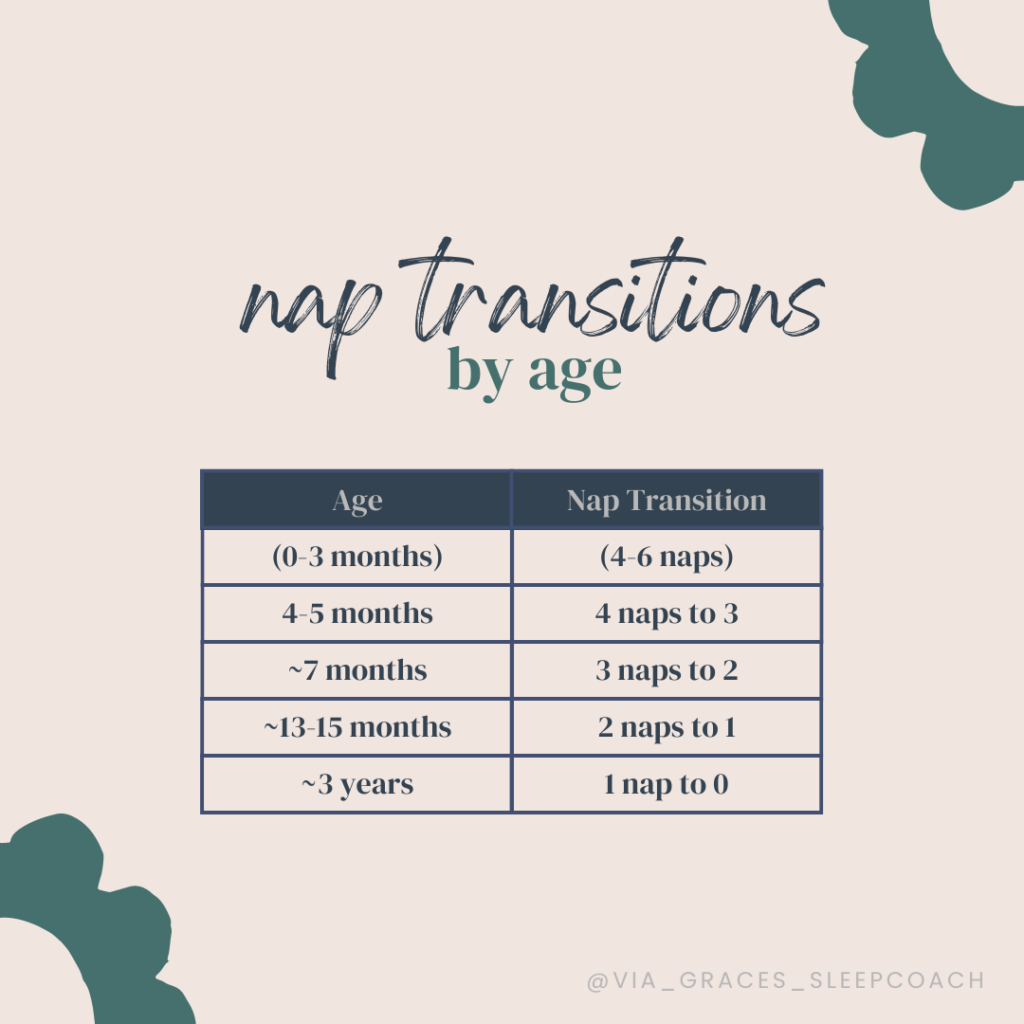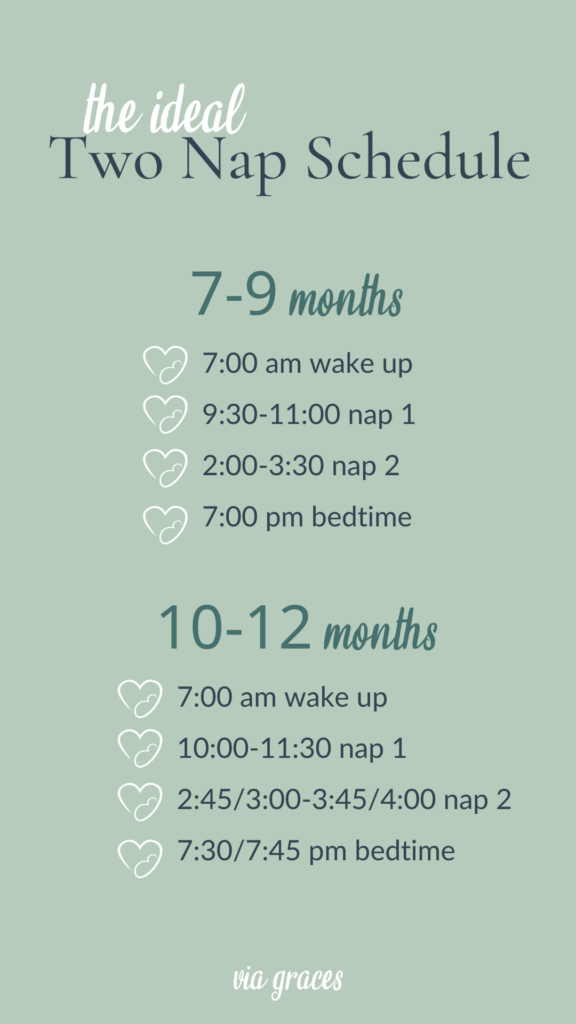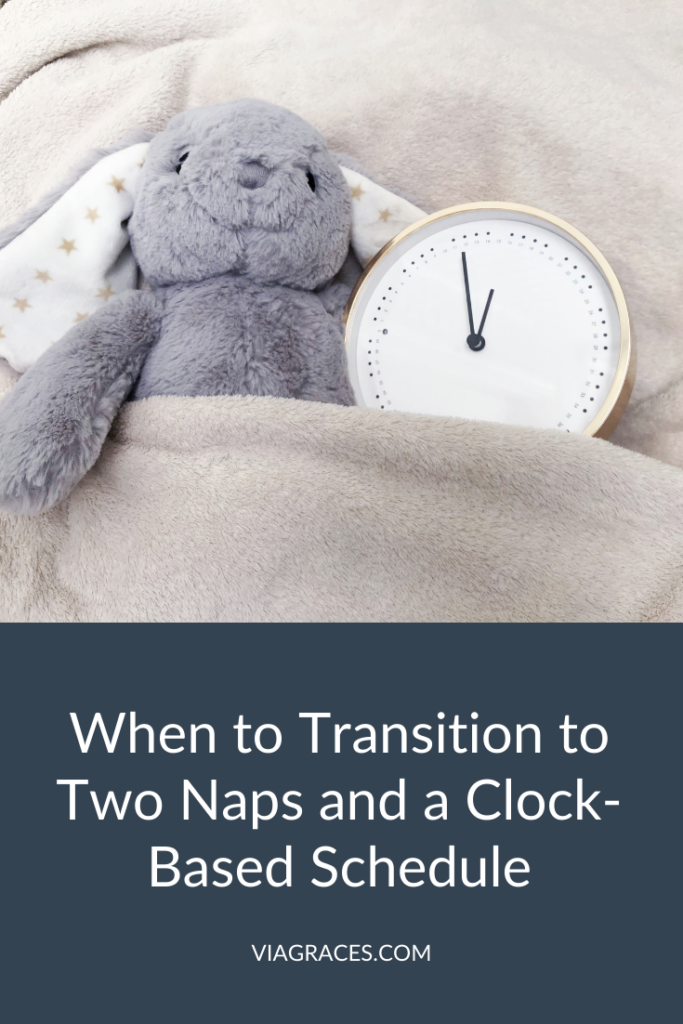Nap transitions can be tough, and in both my personal and professional opinion, transitioning babies from three to two naps can be scary and feels like “uncharted territory,” AND it’s also an exciting transition!
Your baby can finally start moving to more of a set, clock-based sleep schedule rather than focusing so strongly on awake windows, and that brings a lot of freedom to your day!
So in this blog post, we will walk through:
- What age babies are ready to transition from three naps to two naps
- How to go about transitioning from three to two naps
- When you can switch from focusing so much on awake windows to following a clock-based schedule
- How to transition from an awake window schedule to a consistent two-nap schedule
- Ideal nap schedules for babies taking two naps
And so much more!
What age are babies usually ready to transition to two naps?
Most babies make the transition around 7 months old, though I have seen babies as young as 6 months transition, and I’ve also seen babies hang on until around 8 months.
If your baby is 8+ months and takes three great naps and sleeps 11-12 hours overnight, then there’s really no need to switch! If, however, your baby is 8 months old, is still taking three naps some days, and sleep is a struggle (naps and/or bedtime), it’s time to transition to a two-nap schedule.

Signs babies are ready to transition to two naps
The most common sign your baby is ready to transition to two naps is that there’s just not enough time in the day to squeeze in that third nap without pushing bedtime too late. At this age, a bedtime between 6:30-8:00 pm is ideal, and we’re looking for around 11-12 hours of nighttime sleep. So if you’re finding that with 3 naps bedtime is regularly getting pushed beyond 8:00 pm, it’s likely time to switch!
Similarly, if your little one is around 7 months old, is still taking three naps, and is napping fairly well during the day, but regularly wakes up before 6:00 am most mornings, it’s also likely time to transition to two naps, as they may not have enough built up sleep pressure to fully make it through the night!
Finally, if your baby is starting to refuse that third nap, and no matter what you do you just can’t seem to make that cat nap work, it’s likely time to transition to two naps.
How to make the switch from three naps to two naps
The most important consideration for the transition from three naps to two to be able to happen is the schedule and how much awake time your baby can handle.
It’s okay if your child can still only handle around 2.25 hours of awake time in the morning, but we want to see that afternoon awake time stretching closer to 2.75 hours or so. The “end goal” of awake windows for a consistent two-nap schedule is 2.5 hours in the morning, 3 hours in the afternoon, and 3.5 hours in the evening, but it might take some time to get there! And we’ll dig into that more soon.
There may be a few days at the beginning of the transition that you still need to offer a third little cat nap to make it to bedtime, so in that case I would plan on making it a nap on the go (i.e. stroller or car) and plan for a short 20-30 minute nap. This will help bridge the gap between nap and bedtime without too much overtiredness.
As your baby adjusts to just two naps a day they will likely need an early bedtime as they’re not quite ready for wider awake windows, and/or their naps haven’t fully lengthened yet. An “ideal” early bedtime is around 6:30 pm, though I’ve been known to put my girls down as early as 6:00/6:15 during nap transitions.
Finally, one of the most exciting pieces of this 3 to 2 nap transition is you can now get your baby on a set schedule! So let’s chat about what that looks like…
“When can I get my baby on a clock-based nap schedule??”
At some point in their parenting journey, most parents ask this question – they’re craving that by-the-clock nap schedule! The answer: once they transition to two naps!!
For newborns and young babies, awake windows will dictate the entire schedule and routine of the day. Which is, in essence, a “clock-based schedule,” but your baby will certainly not be napping at the same time and for the same length each day.
Now, however, rather than focusing so closely on awake windows, the end goal is that you will be able to look at the clock and know that at the same time every day, your baby should be napping.
We essentially help set your little one’s circadian rhythm around the clock, and this schedule is formed around what awake windows are developmentally appropriate at your baby’s age.
And then they can be on a set schedule from here on out, which is amazing!

Do I have to move to a clock-based schedule?
The short answer is no! If you have been following awake windows and it’s working well for you, you can absolutely keep doing so.
But here are the scenarios where I encourage parents to make the switch from solely focusing on awake windows to following a clock-based schedule:
- Your little one has transitioned to two naps and you want to go by the clock!
- Your baby has gotten into a pattern of early bedtimes and therefore early wake-ups and you can’t seem to get out of the cycle.
- Your baby regularly takes two naps but their naps are short and inconsistent.
- You’re having a hard time figuring out how to drop the third nap while avoiding overtiredness, but your child’s bedtime is getting too late (past 8:00 pm).
- Your little one has transitioned to two naps but something is just off.
All that to say, if you’re trying to stick with awake windows and it’s just not working, switch to a clock-based schedule!
Most babies and toddlers I work with thrive on that schedule consistency and predictability, so I highly recommend a by-the-clock two-nap schedule.
The Best Two-Nap Schedules
7-9 Month Schedule
When transitioning to a two-nap schedule, or when I’m helping a family with a baby in the 7-9 month range, I almost always start with the following schedule:
- 7:00- wake up
- 9:30-11:00 nap 1
- 2:00-3:30 nap 2
- 7:00 bedtime
That schedule is based on 2.5 hours awake in the morning, 3 hours awake in the afternoon, and 3.5 hours awake before bedtime.
Some babies reach 10 months old and that schedule example is still working well. Awesome, then no need to change! My youngest was on that above schedule from about 7 months old until 14-15 months old before we had to make any adjustments. When it works, it works!
But sometimes, in that 10-12 months range, we find babies need a slight shift, yet still definitely need two naps.
10-12 Month Schedule
If you were following that former schedule for a few months and your baby was falling asleep smoothly for both naps, but now all of a sudden is taking 10+ minutes to fall asleep for their morning and/or afternoon nap over a few days, then it’s likely time for a schedule adjustment.
Or if your baby is still falling asleep in great time, however, what was once a 1.5 hour nap is now a 45-minute nap, it is likely time to push that nap back a bit later.
A schedule like this often works well:
- 7:00- wake up
- 10:00-11:30 nap 1
- 2:45/3:00-3:45/4 pm* nap 2
- 7:30/7:45 pm bedtime
*Yes, sometimes that means you’ll have to wake your baby up from nap two! When on a two-nap schedule, we are aiming for no more than 3 hours of daytime sleep. This is important so we don’t cut into overnight sleep (the goal is 11-12 hours) and so bedtime doesn’t get pushed back much later.
Now, hearing these schedules might kind of freak you out. Does your baby really have to follow those perfectly? No! I will say, most babies do well with a very similar schedule, but babies are not robots, it might look differently for some.
My youngest pretty quickly settled into a two-hour morning nap and a one-hour afternoon nap, and I loved it! It gave me lots of time in the morning to clean up breakfast, maybe exercise, homeschool my older girls, etc.
So her schedule was more like 9:30-11:30 nap one, 2:30-3:30 nap two, and 7 bedtime, and we loved it.

How to Switch from an Awake Window Schedule to a Set Two-Nap Schedule
1. When making this switch, I always start with the morning nap.
If your baby wakes up for the day before 6:00 am, consider it a night waking and respond accordingly. If your baby wakes up before 7:00 am, try to keep them in their crib until as close to 7:00 as possible.
Then, regardless of if your child woke up at 6:00, 6:30, or 7:00 am, our goal is to start the first nap at 9:30 am.
Yes, I know that means an early riser will be awake extra long and overtiredness is a concern, but this is the best place to start. If your baby really can’t make it to 9:30, it’s okay to put them down a bit sooner, but no earlier than 9:00 am; you can work your way up to 9:30.
While your baby is adjusting to having a set morning nap, I suggest you keep following awake windows before the second nap and bedtime.
2. Once the morning nap is set, we then focus on setting that second nap.
The ideal would be that your little one naps in the morning from 9:30-11:00, so that natural three-hour awake window would land us at 2:00 pm for the second nap of the day. The idea of a clock-based schedule, however, is that even if your baby only sleeps for 45 minutes, or an hour and 15 minutes, we still wait for that second nap to be at 2:00 pm.
If your baby’s nap is a bit shorter than ideal, do your best to keep them in their crib until as close to 11:00 as possible – remember, we’re trying to train their body clock! Even if you have to get them sooner, you will still base their next nap as if they woke up at 11:00.
Same thing for that afternoon nap…our aim is for it to be until 3:30 (1.5 hours), so even if your baby wakes sooner, try to keep them in their crib until as close to 3:30 as possible.
We’re then aiming for a 7:00 pm bedtime, although when you first make this transition, your baby may need a bit of an earlier bedtime (i.e. 6:30 pm), and that’s totally normal! That will help accommodate for any overtiredness as they can tag on any lost sleep into their night.
3. Remember nap transitions take time!
It generally takes around 4-6 weeks for babies and toddlers to adjust to nap transitions, and that is certainly true of the three to two-nap transition.
Your baby may transition to two naps fairly smoothly, but they might still need an early bedtime for a few weeks as they adjust to wider awake windows. Or they may still be taking two shorter naps. Or they may adjust to setting the first nap of the day fairly easily but may take time to adjust to a set second nap of the day.
And this is all very normal! After 4-6 weeks, you should feel like you’re finally in a consistent groove of two long naps and a clock-based schedule. And if you’re not, it’s time to do some problem-solving!
The “30 Minute Rule” of Two Nap Schedules
With a nap schedule that is set around the clock, we want to keep our babies within 30 minutes of the “ideal” schedule, so as to not confuse their body clocks.
So if your baby usually sleeps for 1.5 hours in the morning, but for whatever reason only slept 40 minutes that day, you don’t want to bring their second nap forward an entire hour. The ideal would be that your baby still takes their second nap at the same time as every other day (i.e. 2:00 pm), but if they’re really struggling to get there, 1:30 pm would be the earliest you would want to lay them down.
Similarly, if your baby has a rough afternoon nap, 6:30 would be the earliest bedtime for a child who generally goes to bed at 7:00 pm. (Unless, of course, your little one skips an afternoon nap altogether, then a 6:00 pm bedtime is definitely necessary!)
We have this “30-minute rule” because once we set their little body clocks, straying too far from that schedule will make a nap or bedtime much more challenging to fall and/or stay asleep.
Conclusion
I know that nap transitions are tough, and transitioning to a set schedule can feel daunting, but it’s so worth it!
Some of you may be reading this and thinking, “Wow this sounds so strict! I don’t want such a set schedule for my child!”
First of all, I want to tell you that kids THRIVE on consistency, and having set nap schedules helps give them that. Are some kids able to sleep well and never have a schedule like this? Sure!
You don’t have to transition to a set nap schedule if what you’re currently doing works for you, however, if your child is struggling with their naps, or following awake windows has been overwhelming, now’s the time to make the switch!
Finally, if you’re looking for more help when it comes to your baby’s schedule and how to continue navigating their sleep schedule as they get older, go snag our FREE Ultimate Guide to Baby Sleep Schedules!)
With Grace,
Lauren
Did you find this helpful? I’d love for you to follow me on Pinterest and pin it for later!
